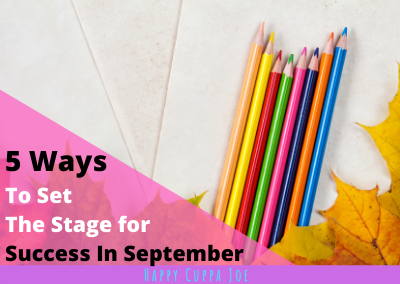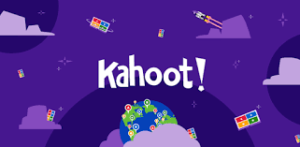September is easily one of our busiest months as teachers, the workload sometimes seems to never end! Follow these 5 easy tips to manage your classroom, create balance in your life, and ensure a successful school year!
Throughout the years, I have found it helpful to create little monthly checklists for myself to make sure that I keep myself on track. This makes it easier to “turn school off” and take a break, knowing that the necessary work is done for now. I think that this is a super important lesson that can sometimes be overlooked or thrown on the back-burner. But we really do have to make sure that we’re doing everything we can to take care of ourselves. This gives us the best shot at successfully taking care of 20-25 others this year!
My number one focus in September is always around connections in the classroom and how my students and parents are feeling. I like to remind myself that community builders are not just for September! Maintaining the time and space for students to connect in your classroom is key to ensuring a warm and safe classroom climate. It’s in this kind of learning environment that your students will thrive academically throughout the year!
Positive connections with parents will also make for a much more successful school year. (Check out this awesome post on Parent Communication Tools by Rachelle and Natalie on WhatTheTeacherWantsBlog.com).
Make sure that you have a solid communication tool in place to keep open lines of communication throughout your school year. In my Grade 4 classroom- we do this through a monthly calendar/email home as well as daily agenda notes. My October email home is usually when I also talk about the value of the teacher/student/parent connection. This lets parents know that I believe that teamwork will ensure their child’s success this year.
Near the end of September is also where I revisit my year plan, assessments, IEPs and any other planning that I’ve done. I do this to see if there are any changes I should make to my plans now that I know my group. (Side note- don’t ever go much further than a scope and sequence in August before you get to know your students! You may find that that your students’ abilities are not as expected, no two groups are ever alike! You also want to leave room for some authentic inquiry-based learning in your year!)
Alright enough with the gabbing, here are 5 Ways to Set the Stage for a Great Year in September!
1. Parent connections
Make sure that you have all of your parent emails confirmed so you can start to use your Parent Group email to keep everyone updated throughout the year. You might also want to use other social media to stay connected to families such as SeeSaw or Instagram. Just make sure you have the appropriate forms signed before you start if your division requires them!
Now that you have those in place, take the time to send positive emails or make phone calls home.
Making a positive connection with parents at the beginning of the year will help jump start your positive relationships with them. Once you’ve done this, it will make future communications much easier. This is especially true if you have to have a tough conversation about their child’s academics or behaviours in class.
These reach outs can be easier to do if you make yourself a simple template to use. (Shout-out to my fabulous teaching partner Annika Sherwin for this idea!). It doesn’t have to be much, here’s a simple example:
“Hi _______, it’s Miss Banks calling, how are you? I just wanted to give you a call to check in and see how ______ is enjoying his/her year so far? It’s been so great having him/her in our room this year, insert student specific positive here!
-
-
-
Examples:
-
_____ has the best attitude when it comes to learning, his hand fires right up in class conversations no matter what the topic!
-
_____ is such a kind student, she’s one of the firsts to offer to help no matter who it is that is asking!
-
_____ has the best attitude, the other day we learned the definition of flexible in our classroom when she _____.
-
_____ brings the most positive vibes to our room, just comes bouncing in every day with the best smile, ready to go!
-
-
-
*This year especially, check in to see how the whole family is feeling with school looking as different as it does!*
2. Student connections
By now you’ve got their names memorized, but what else do you know? What hobbies do they enjoy? Who are their family members? Which subjects do they enjoy the most?
Make a point to try to connect to each student somehow. (Example: shopping, sports, family/siblings, etc). This can be done through community building activities, by joining in on Spirit chats in the morning, or through journals. (Just a word of caution, for every 1 entry you ask them to write- you’re going to have to reply to about 20! I think once a week is lots for this activity!)
How are your students doing in the classroom so far? Could you tell a parent who their friends are in the room?
This can easily be done with an exit slip at the end of the day or before a recess break. Ask them for a quick response on a sticky note- who’s their best friend in the room? What’s one thing they wish their teacher knew? Do they like where they sit? What’s their favorite thing about Grade 4 so far? Is there something they’re missing from other years?
3. Formal Assessments- where are you going?
Year plans are great, but if you notice right out of the gate that 70% of your class is struggling in a certain area, you have some work to do. It may be beneficial to start your year in an area that your students are struggling in or at least move it up the list in importance! Using formal assessments is a great way to find out where your class is at. Just be careful that these assessments don’t feel too heavy for your students.
Regardless of the assessment, I always start out by letting them know that what we’re doing isn’t going to be used for report cards. Instead, this is just a chance to let me know where they’re at so I don’t waste their time with stuff they already know! (This can be a good time to have a chat around meta-cognition with them too! As learners, it’s important for them to understand what they know already and can work on next as well). There are lot of quick assessment options that you can use, such as:
-
Interviews:
-
These are really good for math and reading- just beware that they can take a lot of time depending on how much you have to ask each student. I usually use a combination of written tests with interviews to help speed up this process! For example, have them all start working on a math assessment and use that hour to pull students one at a time for a quick interview on one or two sections of the test.
-
-
Checklists
-
These can be used in many ways as well, one way that I often use them is in math. I give students a laminated 100 Chart for their math bags at the start of the year, this way they can all use the backs for a whiteboard as well. Then I can ask questions to the whole group, such as how many ways can you make this number in two minutes or less? Now I can quickly and easily walk around the room to check off whatever outcome I’m assessing for. The best part with checklists is that the students don’t have to know that they’re being assessed at all!
-
-
Technology
-
Kahoots– there are tons of pre-made activities and interactive lessons made up for you. Or you can very easily create your own Kahoot and use t his for a quick formative assessments.
-
-
-
Microsoft forms– These are super quick and easy to create as well! There are many ways to quickly and easily collect data such as true and false questions or multiple choice.
-
4. IEPs- are your November goals ready and planned for?
Now that you’ve checked in on most of your students, take some time to check in on your students with individualized plans. Make sure that you and your Educational Assistants are all on track with what your student’s primary goals are.
Along with revisiting goals, consider how you and your educational assistants going to track progress. Build progress reporting into a routine so that it’s not forgotten about or put off until report cards roll around. I have found that creating checklists for each IEP goal is a good way to keep our team on track.
(Grab your FREEBIE for tracking IEP goals here!)
I also put a note at the end of each calendar month to remind myself to check in on these goals myself if I haven’t already!
5. How are you??
When is the last time that you took at least a few hours or a full day for yourself?
Not everything needs to be planned ahead, but taking the time for yourself can easily be forgotten about. I like to throw a post-it on each calendar month to remind myself to plan at least one wellness day. This might be a “me day”, a night with friends and family, or an extra date night with Shaun. Holiday months are usually more balanced with family time, but September and October can sometimes get away on me!
So plan a day right now to do whatever it is that makes you happy!
This can be a day spent alone with a book, a hike with your family, or a golf game with friends. Just make sure that there is no work talk involved! I’m lucky to have a partner in crime that loves the spa just as much as I do, so we book our spa days months in advance to make sure we take the time to re-charge!
When do you “turn off” school?
September is one of our busiest months, and it can be easy to fill our entire days/nights/weekends with school work. We think that if we work hard enough, we’ll get everything marked off of our To-Do lists. I promise you though, there is always more work to be found! (And if there’s one thing I’m good at, it’s finding more that I can do, or do better. Laminate more games, freshen up bulletins, organize my desk or filing cabinets, look for new ways to improve units. The list truly does go on and on!)
Remind yourself that we work to live, we don’t live to work. It can be easy to become all-consumed in this profession, especially when we know that our work directly has an effect on all of these little people. But there’s only so much we can do, especially if we aren’t taking care of ourselves
PS. Wonder why you’re feeling so tired at the end of the day or the week??
Last week I tried to sort out what I was doing wrong that I felt so cranky and tired after lunch every day, even with the best laid out plans.
So I did a little research and found this out…
We have all just gone from a summer of relaxing with friends and family, to making anywhere between 10,000 and 15,000 decision in a day! That’s a ton of mental strain that we’re experiencing, even with the best laid out day plans.
Right now- remind yourself that it’s OK (and very much necessary) to take breaks from school.
This is still a work-in-progress for me, especially since starting my life with Shaun and his three little ones. Throughout my single years, it was easier for me to pack many of my nights full of school work. Without a family of my own, I didn’t really miss out on anything, even though it wasn’t very good for me.
One thing that I have found helpful is to pick one night every 3 weeks or so that I bring all of my marking home.
Until then, it stays at school in organized piles in my marking drawer. It means that I end up with a full night of marking, but I try to make it fun with a good glass of wine and my favorite take-out! I try to do this on a Thursday so that by the end of the day Friday- I’m feeling great about where I am at school. This means I can easily leave it all there to continue on with on Monday and enjoy my weekend!
This also makes my prep time feel less crammed. I know that I can use my preps to plan future lessons, keep up with emails, or anything else that the day throws at me. Marking still gets done as much as I can, but I’m not nearly as anxious when I don’t get through it all in time!
Conclusion
As teachers, September is one of our busiest and sometimes most hectic months of the year. Trying to juggle everything can be overwhelming, even to experienced teachers with many years under their belt. Making sure that your students and parents feel a positive connection to you is a great way to get your year started. This will be your best bet at student success and maintaining positive relationships throughout your year.
Try to focus some of your time and energy on working out some ways to maintain a healthy work-life balance.
Your students (and your families) will thank you for it!
The following two tabs change content below.


Micki Banks
Micki has been working in education since 2014 and is currently finishing her Master of Education degree , specializing in Guidance and Counselling. She is currently a Guidance Counsellor at a K-8 school and has a range of teaching experience in Grades 2 through Grade 5. Her passions are relationships both in and outside of the classroom as well as the mental health of teachers and their students.
Latest posts by Micki Banks (see all)
- Masters Portfolio - October 15, 2024
- Graduate Summative - October 15, 2024
- Expressive Therapies - October 15, 2024



